
Nashville, often known as Music City, is the capital and most populous city in the U.S. state of Tennessee and the county seat of Davidson County. Located in Middle Tennessee, it had a population of 689,447 at the 2020 U.S. census. Nashville is the 21st most populous city in the United States, and the fourth most populous city in the southeastern U.S. Located on the Cumberland River, the city is the center of the Nashville metropolitan area, and is one of the fastest growing in the nation.

Belle Meade is a city in Davidson County, Tennessee. Its total land area is 3.1 square miles (8.0 km2), and its population was 2,901 at the time of the 2020 census.

Vanderbilt University is a private research university in Nashville, Tennessee, United States. Founded in 1873, it was named in honor of shipping and railroad magnate Cornelius Vanderbilt, who provided the school its initial $1 million endowment in the hopes that his gift and the greater work of the university would help to heal the sectional wounds inflicted by the American Civil War. Vanderbilt is a founding member of the Southeastern Conference and has been the conference's only private school since 1966.

Mount Olivet Cemetery is a 206-acre (83 ha) cemetery located in Nashville, Tennessee. It is located approximately two miles East of downtown Nashville, and adjacent to the Catholic Calvary Cemetery. It is open to the public during daylight hours.

Centennial Park is a large urban park located approximately two miles west of downtown Nashville, Tennessee, United States, across West End Avenue from the campus of Vanderbilt University. The 21st-century headquarters campus of the Hospital Corporation of America was developed adjacent to the park.

The Tennessee Performing Arts Center (TPAC) is located in the James K. Polk Cultural Center at 505 Deaderick Street in downtown Nashville, Tennessee. It occupies a city block between 5th and 6th Avenues North and Deaderick and Union Streets. The cultural center adjoins the 18-story James K. Polk State Office Building.

William Giles Harding was a Southern planter, attorney, and horse breeder who was made a Brigadier General in the Tennessee militia before the American Civil War. He took over operations of Belle Meade Plantation near Nashville from his father in 1839. During the course of his management, he acquired more property, expanding it from 1300 acres to 5,400 acres (22 km2) in 1860. He specialized in breeding and raising Thoroughbred horses, as well as other purebred livestock. In 1862 after Union forces took over Nashville, Harding was arrested as a leader and imprisoned at Fort Mackinac in northern Michigan on Mackinac Island for six months. He was released on a $20,000 bond. After being imprisoned at Fort Mackinac, he took the oath of allegiance to the Union and did not take an active part in the conflict from 1862 onwards.

Riverwood is a privately owned historic house located in Nashville, Tennessee, United States. At 9,200 square-feet it sits on 8 acres of its original 2,500 acres. It has been a wedding and event facility since 1997.
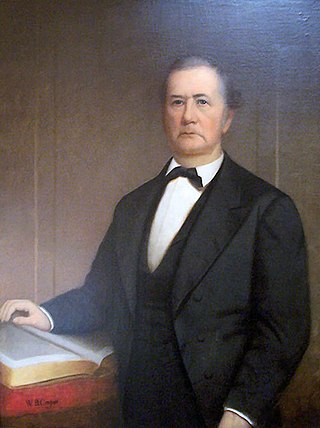
Alexander Little Page Green was an American Methodist leader, slaveholder, and co-founder of Vanderbilt University. He was the founder of the Southern Methodist Publishing House. He was instrumental in moving the Methodist General Conference to Nashville, Tennessee, where he was the minister of McKendree United Methodist Church. He was an authority on fishing.
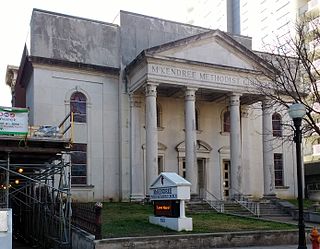
The McKendree United Methodist Church is a United Methodist church in Nashville, Tennessee.

The Gilbert Mansion is a historic mansion in Nashville, Tennessee, U.S.. It was built for a Hungarian immigrant who founded Belcourt Theatre. It is listed on the National Register of Historic Places.
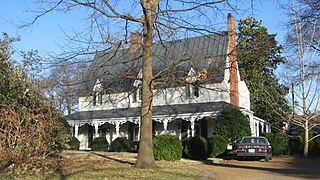
Glen Oak is a historic mansion in Nashville, Tennessee, U.S..
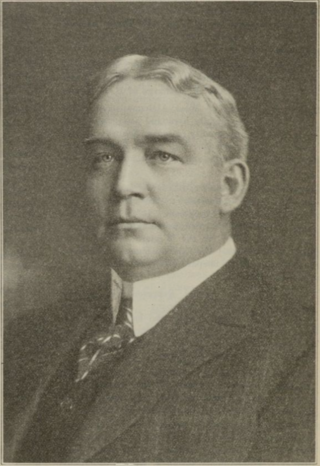
Whiteford Russell Cole was an American businessman. He was the president of the Louisville and Nashville Railroad from 1926 to 1934, and a director of many companies. During the railroad strike actions of 1921–1922, he threatened his workers with dismissal and loss of pensions. His mansion in Louisville, Kentucky, is the official residence of the president of the University of Louisville.
Donald W. Southgate (1887–1953) was an American architect. He designed many buildings in Davidson County, Tennessee, especially Nashville and Belle Meade, some of which are listed on the National Register of Historic Places.
Edwin Augustus Keeble was an American architect who was trained in the Beaux-Arts architecture tradition. He designed many buildings in Tennessee, including homes, churches, military installations, skyscrapers, hospitals and school buildings, some of which are listed on the National Register of Historic Places. He is best known for Nashville's landmark Life and Casualty Tower built in 1957 which was the tallest commercial structure in the Southeastern United States at that time. It reflected an architectural turn to modernism and was one of the first buildings emphasizing energy efficiency.
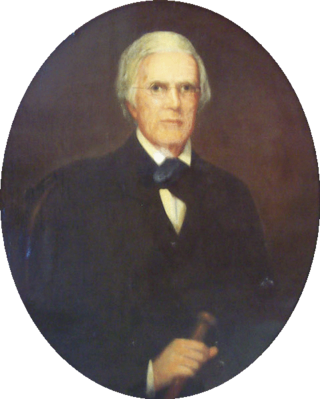
Joseph Thorpe Elliston was an American silversmith, planter and politician. He served as the fourth mayor of Nashville, Tennessee, from 1814 to 1817. He owned land in mid-town Nashville, on parts of modern-day Centennial Park, Vanderbilt University, and adjacent West End Park.
William R. Elliston (1815–1870) was an American planter, slaveholder and politician. He served as a member of the Tennessee House of Representatives from 1845 to 1847. He owned Burlington Plantation in what is now Nashville, Tennessee. An investor in railroads and real estate, Elliston entered his horses in equestrian competitions. The former plantation property was later developed as modern-day Centennial Park, Vanderbilt University and West End Park.
William Henry Calhoun (1815–1865) was an American silversmith in the Antebellum South. He was trained in Philadelphia and became a jeweler in Nashville, Tennessee, where he designed silverware in the 1830s-1860s. A Grand Master of the Odd Fellows, he was arrested by the Union Army for his Confederate support in 1863. His work can be seen at the Tennessee State Museum and the Museum of Early Southern Decorative Arts.
Jefferson Street is a street in Nashville, Tennessee, U.S., which developed as the historic center of the city's African-American community. Three historically black universities are located near here: Fisk University, Meharry Medical College and Tennessee State University. In the 1940s-1960s, it attracted many rock and roll as well as rhythm and blues artists. It was a center for the Nashville sit-ins in the 1960s, but the construction of Interstate 40 across the street in 1968 led to its economic decline. Since 2011, Lorenzo Washington and his staff at the Jefferson Street Sound Museum, the neighborhood community music museum is conserving the musical legacies of the 1940s through 1970s.
Henry Clinton Parrent Jr. was an American architect from Tennessee. He designed buildings listed on the National Register of Historic Places in Nashville and Memphis, including the Tennessee State Library and Archives and the Richard Halliburton Memorial Tower on the Rhodes College campus.














